Lilies are a multi-skinned herbs that grow out of bulbs. In total, there are more than 80 types of lilies in nature. They grow in a wide variety of regions, starting with South Africa and ending with North America. In addition, it is a very beautiful flower, it is often mentioned in the literature. In the ancient Scriptures it was believed that this is a truly magical plant, able to change the fate of people. It is difficult to say whether the lilies are the most mentioned in the culture of flowers, but they are certainly close to such a record.
For long lilies are used in heraldry, they are regularly used for the design of certain coat of arms.
In addition, lilies are actively used in medicine and to date. It is believed that the tincture of this plant is able to heal faster wounds, remove heart pain and even stop the unpleasant effect of the dental nerve. Of course, now scientists note that the effect of this plant is not the biggest, but therapeutic properties still have a place to be.
In this article we will talk about landing, growing and caring for lilies in the open soil.
Appearance Lilies
According to its size, tiny bulbs lilies can reach 1 cm in diameter, and large - up to 30 cm. Their shape shape, the fastening of the scales occurs on the bottom, where the root growth point is located. The lily stem has a straight form, it is covered with leaves, and at the top is small. As a result, the overall growth of the plant can reach from 15 to 250 cm. Depending on the species, lily leaves can be cooled along the helix, and they can form a fitting outlet.
Directly lily flowers are collected in cylindrical, umbrella or cone-shaped inflorescences. One plant has up to 16 flowers, but there are species that have a slightly more flowers.
The life period of flowers is up to 9 days. In the heart of the flower is a pestle and 6 stamens. Flowers forms can be the most diverse, starting with starfish and ending with invigorate.
If we talk about the color of the petals, then there is also a huge variety, in which some species differ in a dark purple color, and some are bright-scarlet, and even with overflow.
Common types of lilies
At the beginning it is necessary to say that the variety of varieties of lilies can surprise any person. There is really a really huge variety that does not have almost no restrictions on the form or color of the plants. However, the most common are the following varieties:
- American hybrids. This species was obtained by crossing the lily of Humbold, Leopard Lily, Canadian Lily and some other varieties. Flowers can be diverse in their shape, but have distinctive features in the form of good frost resistance. Flowering American hybrids occurs in July. The main requirement of these lilies is the weakness of the soil, abundant watering and rejection of transfers.
- Eastern hybrids. This species is a symbiosis of numerous East Asian species. Most often it is flat flowers that are characterized by sufficiently serious environmental requirements. Reproduction occurs with great difficulty, and viruses can easily make their own "black" business. The flowering of these hybrids begins only on the 5th year of growth, and in this regard the plant looks not very attractive.
- Asian lily. The tax group of plants is a whole list of lilies - tiger, dwarf, david, monochrome, spotted and many others. The strength of all these lilies is frost resistance and many other external factors. Also, plants are unpretentious to the specifics of the care, sufficient and minimum actions.
- Crispy hybrids. The varieties of this group are about hundreds, and almost all of them have one overall feature associated with high growth, chalmid penetrating flowers, as well as a light tint of the flowers themselves. Also, the essential advantage of this group is the frost resistance of flowers, as well as not the most serious requirements for the landing and care site.
Specificity of growing lilies in open soil
It is most important to know that lilies do not like transfers, and often they simply do not tolerate them. The situation is such that in one place they grow several years. The most comfortable conditions for growing lilies are sun plots that are protected from a strong wind. Otherwise, no strict claims simply exist. The soil should be loose, and also differ fertility. In such conditions, the development of the plant will take place as quickly as possible. Many specialists pay a lot of attention to acid-alkaline balance, but most of the lilies are perfectly rooted on neutral soil.
Approximately 3 weeks before planting plants it is necessary to move the soil with ash, peat and humus, it does not prevent add a little mineral fertilizer. After that, the site is heavily, the soil is a bit trambed, irrigated by the territory.
A lot of attention should be paid to the bulbs, especially if they have to buy them. First of all, it should be clarified to what kind they relate. Well, the most important requirements here concern the choice of the most juicy and healthy externally bulbs. With high probability, they will demonstrate active growth, even if the surrounding conditions are not the most optimal.
The time of acquiring lukovits is an important aspect. If the acquisition occurred in autumn, then until the middle of September, you need to land, and until that time you need to keep the bulbs in the wet sand, sawdust or moss. It is advisable for these needs a dark room with excellent ventilations. Most often, sellers together with bulbs give special packaging, which are just suitable for a certain standing period.
Roots plants should be longer than 5 cm.
Already before the landing, it is necessary to make a cleaning of the plant from spoiled scales, which have brown spots, and make a clipping of rotting places, including too long roots.
The process of landing lilies in open ground
Living lilies occurs in autumn, or in winter. Sometimes landing is performed in summer, but growth activity will be no longer such as in the previous two cases. In the spring period, the growth of the root system occurs quite quickly, so the probability of suggestion is high enough. Separate varieties of lilies plant in March, April, sometimes in May.
However, specialists in one voice say that it is autumn that is the best time for planting, since the root system develops before winter, and further if the plant transfers the spring drops of temperatures, there are no threats to lilies simply.
If it is planned to plant several types of lilies in one site, then first in the fall of white lilies occurs, as they are distinguished by the longest period of rest. Already then you can land the landing of Caucasian varieties and American hybrids.
- Landing in the spring. In the hole, which will be used for landing lily, is falling asleep with a small amount of coarse sand. The onion is placed on him on the bulb, after which it is painted her roots and complete sanding with sand. Next, the hole is watered, but before that, all this falls asleep the earth. Often, planting is mounted with sawdust or peat, this layer should be about 5 cm. The depth of immersion of bulbs in the ground may differ depending on the size of the variety. The deeper the landing is made, the later the blossom of lily will begin, but at the same time the bulb will delight a lot of children.
- Landing in the autumn period. In the event that the lilies have grown too thickly, it makes sense to make separation and seating. In the autumn period, landing lilies is in the process of dividing and planting bulbs. After flowering, the bulb is distinguished by looseness, it is necessary to give her for a while to recover. If Lily bloom in June, it is possible to transplant in August. With the help of the forks, digging, the most important thing is that the roots are completely damaged in these actions. It is necessary to tear the ground, remaining at the root, after which the washing of the bulbs occurs under running water. Next is the soaking of the plant for 20 minutes in a non-contactered solution of manganese. After that, drying the bulbs in the shade occurs, the roots are cutting, so that their length does not make up more than 10 cm. Directly landing the treated plant occurs in the same way as in the method described above.
Care of lilies in the open soil
The main part of the work associated with the departure of lilies is irrigated and feeding plants. As practice shows, too much time does not leave for it, so in this plan lilies look quite attractive.
- For active growth, the head of lily should be located in the sun, and the leg is in the shade. Of course, it is not easy to ensure such a recommendation, especially considering the presence of plants nearby.
- Moisture is required by lilies throughout the growing season, and this is the first half of the summer. However, there is a recommendation at which constantly wet soil is not the best condition, since the lilies simply do not like it. Everything must be in moderation, especially if we are talking about regular precipitation. Watering regularly in the arid period of the year, during which each drop of moisture will benefit the plant. Already after the bloom occurred, the volume of watering can be significantly reduced. However, directly watering occurs in late autumn, although minimal.
- The first time the feeding occurs in early spring, when shoots do not appear above the ground. Comprehensive fertilizer is entered into the soil - about 30 grams per square meter. Similar feeding is used during the bootonization period. Already when lilyflows are flowing, the bulbs need to be filtering with potash-phosphoric fertilizers for carrying out a peculiar recovery. We are talking about 10 g of superphosphate, 30 g sulphate per square meter. A little different situation occurs if the lily grows only the first year, with such a situation, it is necessary to carefully remove buds, without letting it disclose them. It will keep the plant's forces, also lily strengthened and next year there will be a full bloom.
- There are certain difficulties in the process of care. For example, Eastern hybrids poorly tolerate the winter. According to experts, they grow in a climate, in which winter weather is dry, and in spring and summer - wet. On the territory of Eastern Europe, the situation is such that everything can be completely the opposite. Therefore, the owners have to resort to sufficiently volumetric work, which is based on the shelter of plants in the autumn film period. The difficulty here lies in the need for regular ventilation of plants, which is carried out only in dry weather.
- Plant lilies in lowland - not the best solution. It is known that in the practice of the nizin is a terrain with high soil humidity, therefore lily in such conditions may not stretch and one season. Many owners complain that they are quickly withering in the lans. But at the same time, lily die from the soil of soil, so it is worth looking for the very golden middle, which will provide plants an active growth.
- Frequent diseases in lilies can also have a place to be. As practice shows, it often happens in cases where manure is regularly used as fertilizer. The bottom line is that often manure is saturated with pathogenic microflora, which is able to create too serious problems for further development of lilies. It should be remembered that these plants practically do not tolerate organic matter.
Proper storage of bulbs lilies
Certain varieties of lilies are not recommended to be left in the soil until the spring period, especially when winter is a harsh environment in terms of low temperatures. Therefore, it is best to simply take and remove lilies from the soil, but there are many requirements for their storage.
- Humidity should not be too low, as the dry space will lead to the fact that the bulbs simply wonder. At the same time, too high humidity can also harm, since the excess of moisture can cause the formation of mold. In addition, it is impossible to exclude the possibility of premature germination, which, of course, cannot be allowed.
- The temperature requirements are also available, and it is desirable that it be moderate. It is impossible to be allowed to be present a minus temperature that quickly makes a lot of problems.
- Good ventilation indoors is also very important. Lack of ventilation, stagnant air - these are the main reasons that the bulbs simply become unsuitable for further growth.
If lilies were only purchased, drying and cleaning plants from the soil should be made, then it will be necessary to arm a wooden box, a cardboard box or other capacity. The bulbs are stacked inside, which fall asleep with a small amount of peat. On top of this layer, another one is created - the bulbs are again located. As a result, it should be possible so that the box is filled with peat and bulbs about 2/3. Next, the container is located in the refrigerator. As a replacement, the refrigerator may be a loggia or refrigerator. It is important to remember that the inside of the box should be checked regularly. It often happens that the roots dried, so you need to wash off peat and wipe the bulbs with a solution of potassium permanganate.
There is an alternative method for storing bulbs. It lies in laying bulbs in a polyethylene package. The basis should be a wet peat, the package itself is inflated, and the bulbs are located on top. The package is tied, after which it is located in a dark place, and about 3 months formed kids. Do not produce the branches of the children you need to transplant the bulbs in peat pots, as a result, the tips of the scales should be located above the surface. All this is put in a cool place. Approximately 2 weeks before landing, you need to transfer plants into the house and start the process of watering.
Events after flowering
- Already after the lilies were fighting, it should not be too rushing and cutting a coloring. At the same time, family boxes are recommended to delete if there are no needs in seeds. The leaves and stems will delight the development before withering, thereby quite good delivery of nutrients for growth for the next season.
- In the autumn period, the blooming can be cut off, but not too low and even at a small angle. Watering should continue, but only if it is needed. With rainy weather, plants must fully have enough precipitation.
- After the transplant of the bulbs and the period of heavy rain rains, frost-resistant lilies must be posed by peat-based mulching, it is possible to use chips. From above, insulation is created in the form of a facothy, it also does not interfere with all this to cover with a polyethylene film.
- Already at the beginning of the spring, the film and the laps can be safely removed so that no curiosities do not happen. For example, the film can harm the formation of the proceeding sprouts. At the same time, peat and sawdust must continue to remain as a mulch for plants.
Diseases and pests lilies
- Lily beetle. This is a fairly serious threat, which often acquires threatening scales. Lily beetles together with their larvae quickly eat leaves and buds, so if you do not respond to this situation on time, then the plants can be simply losing. Good news is that it is easy to remove the beetles by hand, but often it turns out troublesome work, since the plants themselves can be too much, just like pests. If the situation is too aggravated, you can take advantage of solutions, such as accommodation, Akatara, carbofos, etc. The simplest spraying occurs, which occurs with a certain regularity. Unfortunately, after such a kind of processing, lily may lose their initial presentable appearance. As practice shows, the owners just do not have the choice, so you have to spray.
- Medveda, larvae of the May beetle. Unfortunately, these pests create too large threats. Moreover, it is often that between the beginning of the negative impact of the bear and the crust of the plant can pass too little time. As a result, it should be reacting as quickly as possible if a pest was found and use one of the following funds: "Thunder", "Mogyhar", "Grizzly" and others. These funds can be struggling with wires, trips and some other pests.
- To prevent the possibility of the negative impact of pests and diseases, each year should be combustion of all plant residues of lilies.

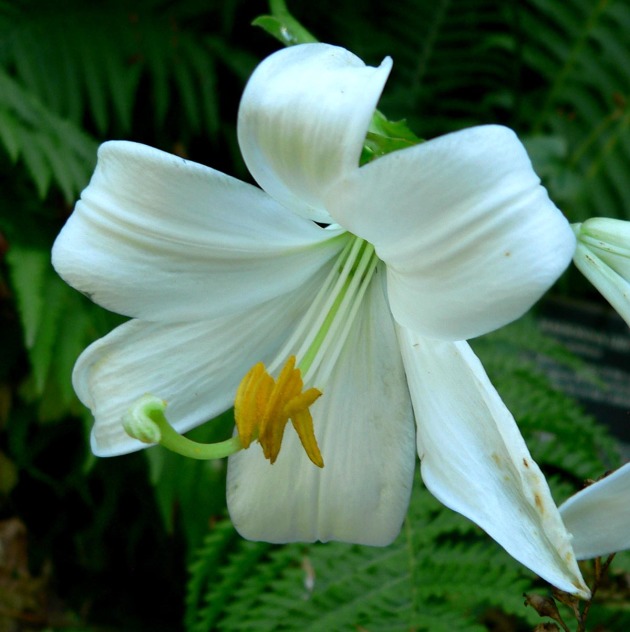
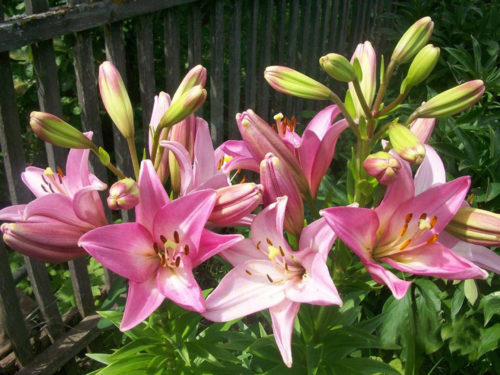
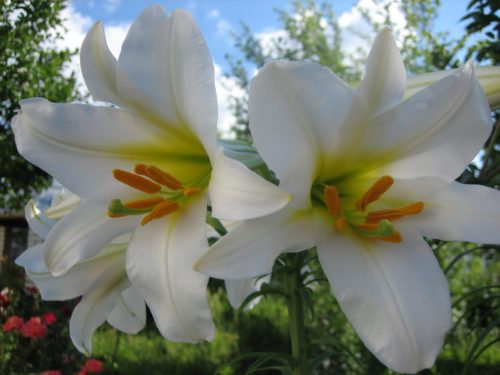
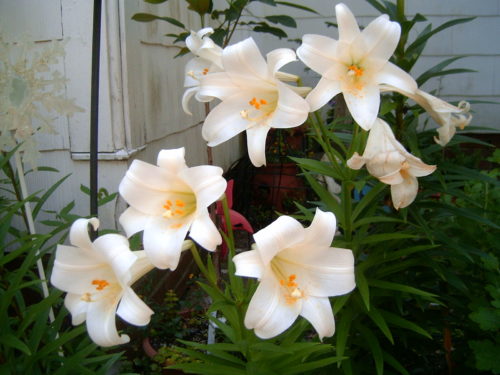
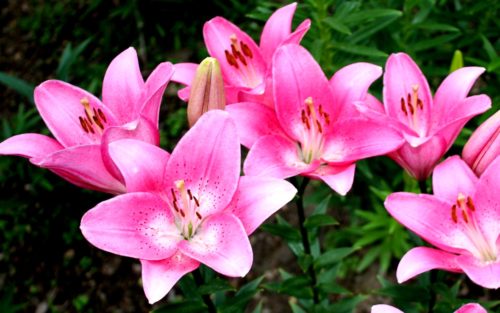
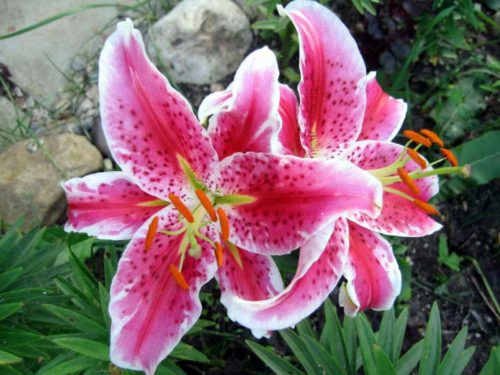
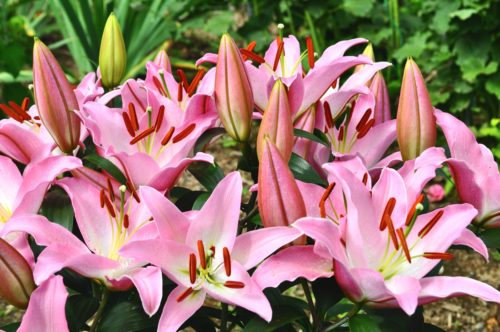












 Start a discussion ...
Start a discussion ...